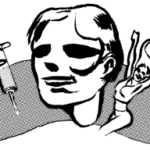Sex, Drugs, and Caroll (sic)
The Great American Music Hall (San Francisco, CA), 18 November 1998
Review by Karina Ioffee, Features Editor
FishWrap Live (UC Santa Cruz)
25 November 1998
Swaggering on stage, beer in hand and dirty blond [sic] locks falling boyishly over his face, Jim Carroll looked like he had come to San Francisco for a night on the town. With his faded jeans and T-shirt, it was hard to differentiate the poet, musician and spoken-word performer from the other members of the crowd, mostly twentysomethings who yelped and hollered as he stepped up to the mic.

“Good evenin’,” he murmured in a Brooklyn [sic] accent, squinting at the bright lights and smiling at the audience who had congregated to hear him speak at the Great American Music Hall. The lights dimmed to a rich blue hue, as Carroll continued. “You know they used to call me Dazy, when I was little,” he said, “because I always walked around as if in a daze.”
This punk era luminary was revealed to the public in the late ’60s with his autobiographical [sic] novel, The Basketball Diaries. If you haven’t read the book, you might remember the movie, which came out in 1995, starring teen heart throb Leonardo Di Caprio. In the film, Di Caprio plays a Catholic high school basketball phenom who drops out and takes to the streets in a heroin induced frenzy which almost ends his life. It is the story of Carroll as not only a drug-addicted junkie and criminal, but also a talented writer with a flair for poetry.
30 years and one healthy recovery later, Carroll is still going strong. He has just put out a new collection of poetry, titled Void of Course, as well as an album, Pools of Mercury.
On top of these achievements, he has written for Andy Warhol and Paul Morrisey films, taught poetry workshops and given poetry readings across the US and Canada.
While no doubt talented, the ’90s Carroll is, in many ways, the same ball-shootin, heroin-snortin, horn ball portrayed in the Basketball Diaries. “Your breasts are so white and I hate whiteness,” he hissed into the microphone, cocking his head to one side. “And why are your nipples so red? You must be younger than you look,” he recited. “I know about that kind of stuff.”
Carroll continued in a similar fashion for much of the night, occassionally venturing to read some fiction, as well as material written by others. It became easy to understand his appeal to a generation of post-punks. No glossy cover up by the movie industry could diminish what Carroll attempted to unveil, as he discussed such topics as poverty, death and our society’s obsession with drugs.
That night, standing in the baroque splendor of the Great American Music Hall, Carroll was all about chance, another one of his favorite topics. Brave enough to challenge the existing structure of language, he found ways to use old words in innovative ways, forcing the audience to imagine wild and often surreal images. Sometimes, he used his words for solely shock value, meant to disorient and amuse the crowd. “If a cat is dragged across the carpet of a 15 by 12 room, it would generate enough electricity to power a standard house for approximetly 5-6 seconds,” he said at one point. The majority of the crowd howled. A few untrained Carroll fans looked confused.
The event was signature Jim Carroll, featuring plenty of the writer’s musings on sex, drugs and the rock’n’ roll culture we live in. Yet this was exactly what he had written about 30 years ago in the Basketball Diaries. Had nothing changed in his life that he felt compelled to write about the same sort of simplistic and juvenile subject matter? It appears not. Despite poetry rich in metaphor and symbolism, Carroll’s work was extremely narrow, looking like he just could not part with what he knew best: the streets, the despair, and the cruelty of life. And while he deserves the utmost respect for his urban eloquence, isn’t it time to move on?
Since when is Jim Carroll a blond, beer-swilling Brooklynite? — Webmaster, CatholicBoy.com
The original article was found here: http://www.porter.ucsc.edu/fishrap/9.4/sexdrugs.html
